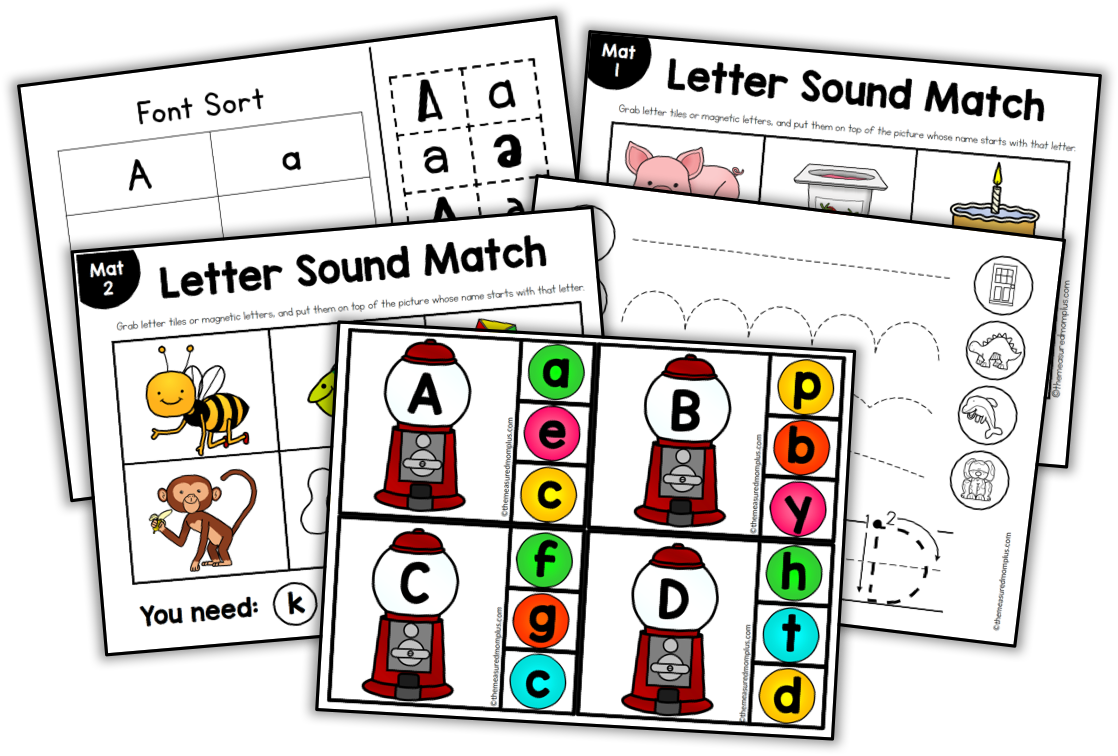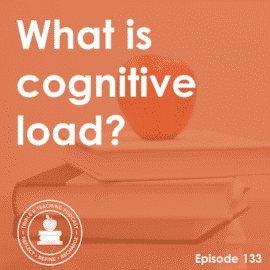TRT Podcast #107: What order should we teach the letters of the alphabet?
Should we teach upper or lowercase first? Which letters should come first in the sequence? And what does the research say, anyway? Get the answers in today’s episode!
Full episode transcript
Hello, Anna Geiger here from The Measured Mom, and we're going to continue our alphabet series today discussing what's the best order to teach the letters of the alphabet.
This is a question I get asked all of the time. And the answer is, it depends.
Here are some questions people often have. Should we go in alphabetical order? Should we start with uppercase or lowercase? What does the research say?
Well first I want to restate what we talked about last week, and that is that research strongly suggests we should teach both letter names and sounds at the same time.
Now, I should note that last week when I recorded the episode, I recorded it on a Thursday, edited it, sent it to my team member who gets it all uploaded to Buzzsprout, and then the next day, Friday, I watched a video by Dr. Shayne Piasta, which is inside of the Reading Science Academy with Dr. Stephanie Stollar. If you're not part of that, I highly recommend it. It's really affordable. I can't remember how much I pay per year, but I think it's like $149 and you get access to just a ton of great resources plus expert interviews like this one. I was really excited to watch it because I'd read a lot of Dr. Piasta's research in working on last week's episode, but I also thought, oh boy, I hope I don't learn anything that means I would have to go redo that episode. Thankfully, I didn't. Everything she said agreed with the conclusions I had drawn based on the things I'd read.
The big one is that research strongly suggests we teach BOTH letter names and sounds at the same time. I think that's important to remember as we think about the order for teaching the alphabet.
The first big question is, should we teach upper or lowercase letters first? According to Dr. Shayne Piasta, there is correlational evidence that children may use uppercase knowledge to learn lowercase letters, but no studies have been conducted to determine which is best to teach first so everything that follows here is going to be based on our best judgment.
What about teaching uppercase letters first? Many preschool teachers would say that is a good way to go. I have a lot of respect for Jamie White. She's over at the blog Play to Learn Preschool. She's done a lot for early literacy. Her website is amazing. She's currently teaching an at-home preschool, and she supports her students when they write their names in all capitals.
Here are some of her reasons. Children see capital letters everywhere and therefore learn them more quickly. Think about alphabet puzzles and toys, they almost always have the uppercase alphabet, right? Capital letters are easier to recognize, and that's important because kids are still developing visual discrimination skills. Think about the capital D and B. Those are much easier to distinguish than lowercase d and b.
Many occupational therapists would agree that teaching uppercase letters first makes sense. Here's an argument from Laura Sowdon. She's an occupational therapist, and she writes at Five Senses Literature Lessons. Here's what she wrote, "Uppercase letters are generally straighter and simpler to form than lowercase letters, which makes them easier to write. Unlike many lowercase letters, capital letters don't require students to write on lines they've already written." If you're thinking about the capital M, it goes down, then you lift your pencil up and go down, up, down. Whereas with a lowercase m, it's down, trace it back up, bend around, trace it back up and around. That act of writing over what they've already done can be hard for kids who are first learning to write. And finally, "Curves and intersections are the hardest parts of a letter to form, and there are fewer of those in uppercase than lowercase."
Now, on the other hand, if the comment section of my blog is any kind of clue, many kindergarten teachers believe that preschoolers should learn lowercase letters first.
Here are some of the reasons for that. When children learn to read, they will primarily encounter lowercase letters. It's also hard to break the habit of uppercase letters in the middle of a child's name or in other words. In one way, you could say uppercase alphabet letters are actually trickier to write because there's so much picking up and putting down of the pencil, whereas with lowercase, it's more of one continuous stroke or more likely to be a continuous stroke.
My conclusion is that if you're teaching preschool, you should choose upper or lowercase based on what you think is best for your students. If you're teaching kindergarten, I think you should start with lowercase because you want your students reading as soon as possible and lowercase letters are primarily what they're going to be reading and writing.
With that out of the way, upper or lowercase, what's the best order to teach those letters?
Well, I think you need to consider your goal. Are you focused on matching letters with sounds? Are you focused on letter formation? Are you merely interested in letter recognition? Whatever is your primary focus will help you choose an order.
Here's how I do it. I recently finished writing a Letters and Sounds Curriculum for Preschool. As of this recording in January of 2023, it's not quite ready. Hopefully in February we'll be done editing it and have it in our shop. But with this program for preschool, I'm mainly focused, in addition to letters and sounds, on letter formation. I wanted to make sure that the letters were grouped based on strokes and, in general, easy to hard in terms of letter formation. When it comes out, you'll see that the program has an uppercase letter sequence and a lowercase letter sequence, and that's because it mixes review all the way through.
Because upper and lowercase letters are formed differently, I have a different order for teaching them. Here's my sequence. When you're listening on the podcast, this isn't entirely helpful, but there are show notes where you can go ahead and copy this down. But the uppercase sequence is like this: T, L, I, F, H, E, those are all pretty much straight lines. D, P, B, straights and curves. O, C, G, U, those are a lot of curves. S, R, Q, again, more curves. And then we've got a bunch of straight letters with slants included: A, M, N, Z, V, W, K, Y, X.
Then the lowercase sequence also starts with the really basic letters - just a line - and then starts to add curves and then slants. That sequence looks like this: t, l, i, j, u, r, n, m, h, b, p, o, c, d, a, g, q, s, f, e, z, v, w, k, y, x.
Now could someone with the same goals that I have, have chosen a different order? Definitely. This is just one way to do it.
In ordering my sequence, I was also conscious that because I'm focused on teaching letter sounds, I'd want to make sure that letters that may be formed very similarly are not right next to each other in the sequence if they have similar sounds. That would be easy for students to confuse the sounds. By that I mean basically short vowels. Letters like A and O, I wouldn't want those right next to each other, even if I felt they were formed very similarly, because we don't want children to begin to confuse those vowel sounds, which is very easy to do when you're teaching them right next to each other. So we may have to make concessions. Again, it's all about our goals.
If you're teaching kindergarten, I think your order definitely needs to have a different focus. We're certainly wanting kids to form letters correctly, and research definitely supports teaching handwriting through third grade, but in kindergarten, our main goal is getting kids to read.
I think we should do lowercase, and I think we want to make sure that those early letters can be grouped to form words as soon as possible. Many teachers would agree that we want those first five letters to allow us to make some words. We want a short vowel, most programs start with letter A, and then some consonants.
How do you choose which consonants to put at the beginning? Well, one consideration is to put as many consonants with continuous sounds at the beginning as you can. A continuous sound would be the sound of /s/ or the sound of /f/, just because we know that it's easier for kids to sound out words when they can connect a lot of the sounds together. In the word Sam, for example, /s/ /ă/ /m/, we've got all those sounds we can hold out versus a word like pat, /p/, /ă/, /t/, where only the A is sustainable. As much as possible, we want sustainable letters at the beginning.
We want to make sure we separate those short vowels. We want to separate consonants that are easy to confuse, like B and D, or P and Q.
Now, for me personally, when I chose my sequence for teaching letters and sounds to kindergarten, I wanted to be able to form words that I could use in stories. For me, there's a difference between reading words in a list and choosing words that can actually tell a story. It's much harder to do the latter.
Because of that, I did have to include a low utility letter that has a stop sound towards the beginning, the letter J. The letter J isn't in too many words, and it's a stop sound. You can't sustain it. That might be an argument for not including it early, but I wanted a story about a little bear named Sam who can't open a jar of jam. Because of that, I need a J early on. To me, that was more important than some of the other considerations.
As you can see, it just depends on so many things. The next time someone tries to argue with you about upper or lowercase letters first or what's the best order, you can tell them that research does not tell us, but we can use our best judgment and our goals to help us choose the right order for our students.
You might want to check out the show notes to get those sequences that I listed, as well as the blog post that this podcast episode is based on. It's got everything laid right out there for you. The show notes for this episode can be found at themeasuredmom.com/episode107.
Talk to you next time!
Sign up to receive email updates
Enter your name and email address below and I'll send you periodic updates about the podcast.
Mentioned in this episode
- Dr. Stephanie Stollar’s Reading Science Academy (highly recommended!)
- Last week’s episode: Should we teach letter names or sounds first?
- Blog post: What’s the best order to teach letters?
- Jamie White: Should children write their names with capital letters?
- Laura Sowdon: Why OT’s tell you to learn capital letters first
Sequences mentioned in the episode
Preschool sequences: Uppercase: T, L, I, F, H, E, J, D, P, B, O, C, G, U, S, R, Q, A, M, N, Z, V, W, K, Y, X Lowercase: t, l, i, j, u, r, n, m, h, b, p, o, c, d, a, g, q, s, f, e, z, v, w, k, y, x
Kindergarten sequence s, j, a, t, p, m, d, c, h, r, n, i, b, f, g, k, ck, o, e, l, v, w, sh, th, u, ch, wh, x, y, qu z








Leave a Comment